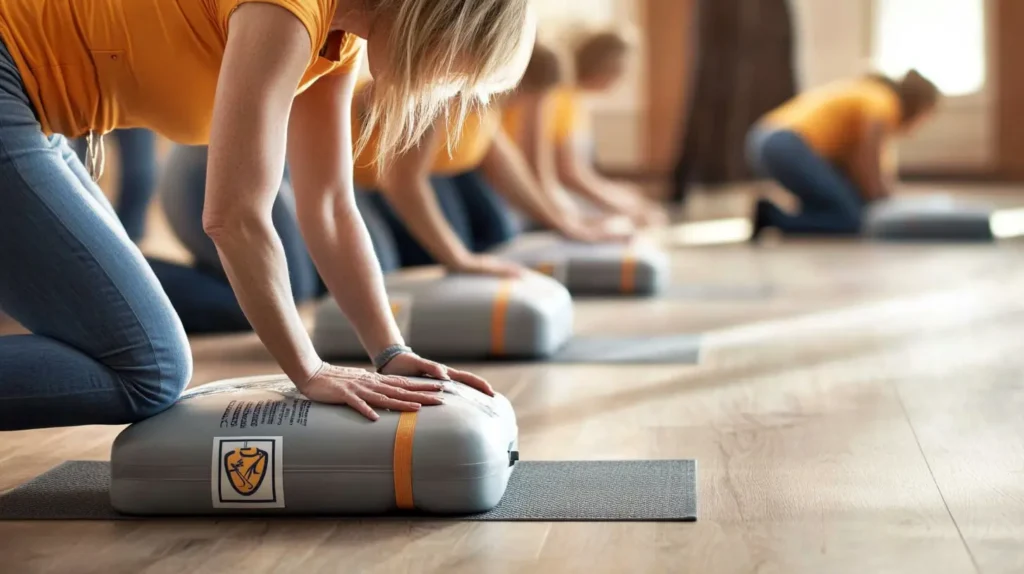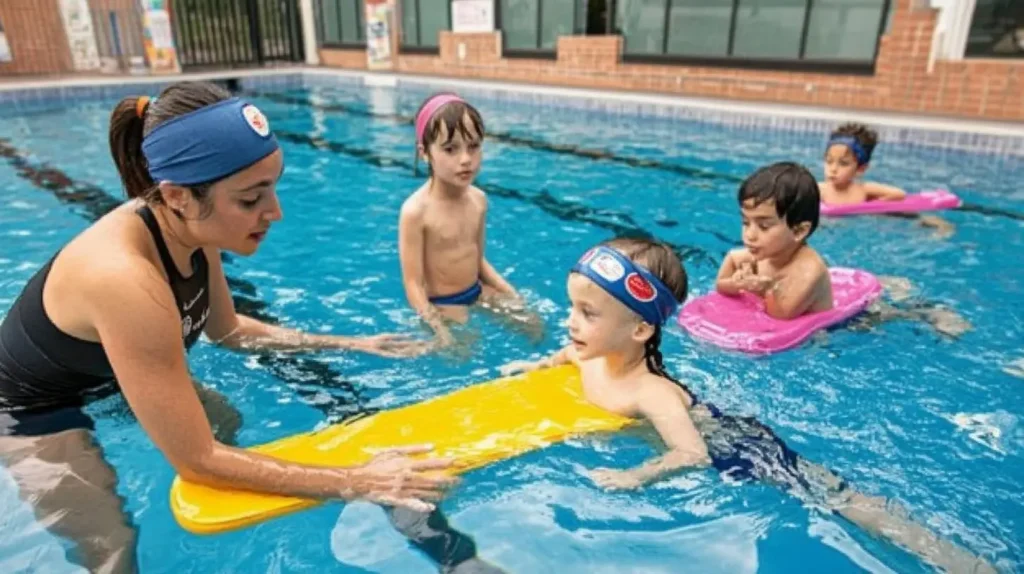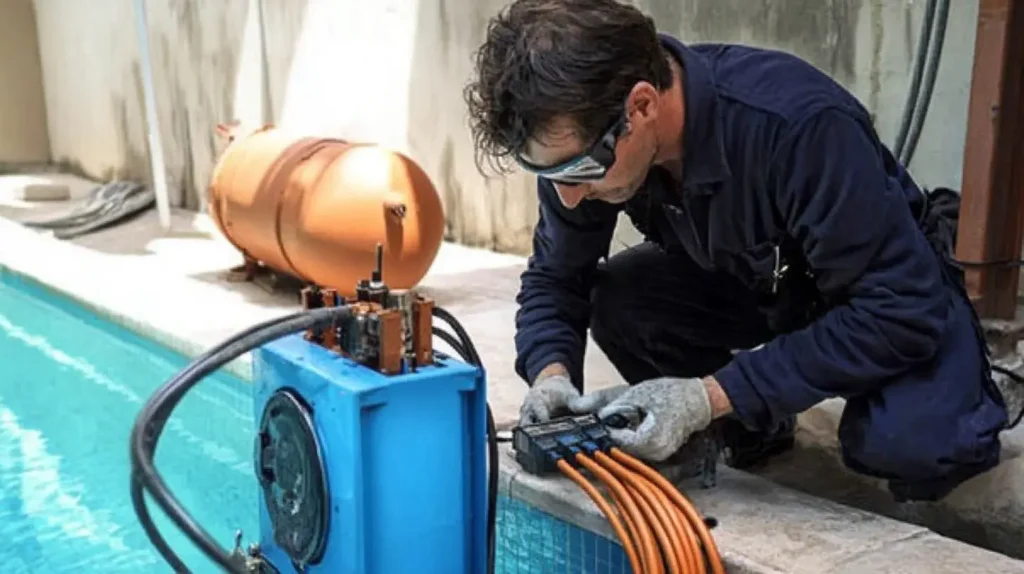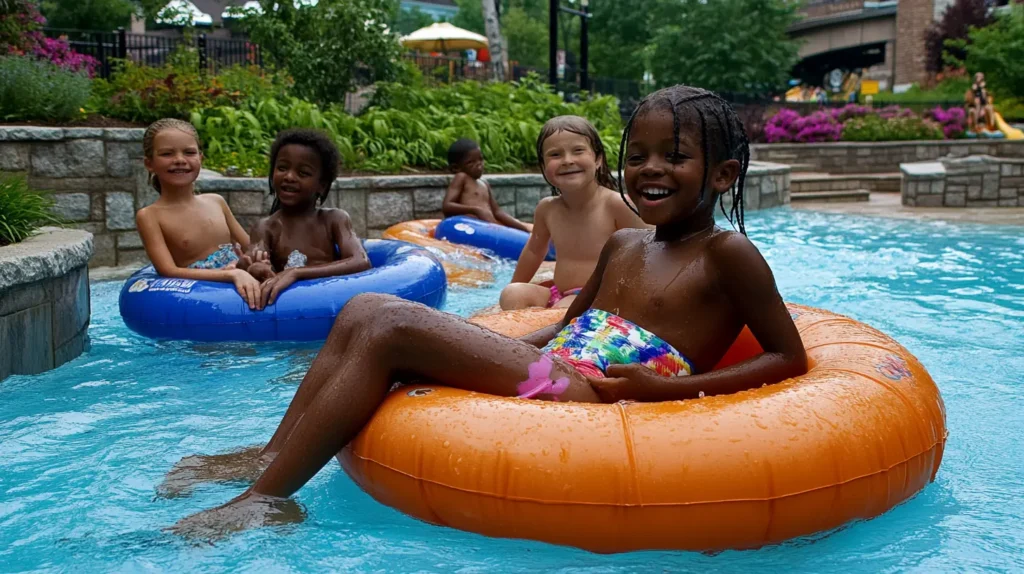Introduction
Every summer in Richmond, Virginia, families eagerly anticipate days spent splashing under the sun, sharing laughs, and creating cherished memories around their backyard pools. There’s nothing quite like the joy of cooling off in the water with loved ones in the midst of our region’s warm, humid weather. However, behind every memorable backyard pool party lies a critical responsibility: safety.
When children, teens, and adults alike dive into the deep end or practice their cannonballs, it’s essential to keep a watchful eye and follow essential pool safety tips. By staying informed on how to protect swimmers, manage pool chemicals, secure the pool area, and understand emergency protocols, you can ensure that your backyard remains an oasis of fun without compromising anyone’s well-being.
At PMC Pools, we’ve been serving families across Richmond and surrounding communities since 1968. Over the years, we’ve seen how proper planning, diligent maintenance, and responsible supervision make all the difference in creating a safe yet entertaining outdoor space. In this comprehensive guide, we’ll share vital swimming pool safety tips that all parents, homeowners, and pool lovers can follow to ensure a secure and enjoyable season. From pool and spa electrical safety tips to effective chemical maintenance, we’ve got you covered. Let’s dive right in!
Section 1: Understanding the Basics of Pool Safety
There’s no question that a well-maintained pool can be the star attraction of any backyard gathering—especially during a scorching Richmond summer. However, before the first splash or floating lounge session, it’s essential to lay a solid groundwork of safety principles. By taking time to establish clear rules, equip swimmers with the right gear, learn life-saving skills, and maintain a secure environment, you’ll create a foundation that ensures every pool day is as safe as it is fun.

1. Establish Rules and Communicate Them Clearly
Think of your pool rules as the “house constitution” for aquatic activities. A few pivotal regulations—like “No Running,” “Always Swim with a Buddy,” and “No Diving in Shallow Areas”—can keep minor mishaps from turning into serious incidents. Write these guidelines down on a bright, noticeable sign and hang it where everyone can see it, whether near the pool ladder or at the entrance to your backyard. The extra visibility reminds both seasoned swimmers and newcomers of what’s expected. And remember, rules aren’t just for children—adults need to follow them too. This sets a consistent example and makes it clear that safety is a family affair.
2. Use Age-Appropriate Safety Gear
From inflatable armbands to Coast Guard-approved life vests, the right flotation device can spell the difference between a carefree splash session and a worrisome close call. Think of age-appropriate safety gear as the seatbelt for your swimming adventures. If you have young children still mastering their strokes, high-quality floaties or life jackets provide extra buoyancy. But be mindful that these devices don’t replace vigilant supervision. Even the best flotation gear works best when an attentive adult is present. Encourage kids to treat floaties as a helpful tool, not a substitute for a watchful eye.
3. Learn CPR and Basic First Aid
Picture this: You’re hosting a neighborhood barbecue, laughter is in the air, and suddenly someone starts struggling in the water. In these critical moments, knowing CPR could be the difference between a close call and a tragedy. Basic first aid skills, including how to treat cuts or identify the signs of heat exhaustion, are equally vital. Fortunately, many Richmond community centers and organizations like the American Red Cross offer classes that walk you through these essential techniques. Signing up for a few weekend sessions is a small investment that pays immeasurable dividends in peace of mind.
4. Maintain a Safe Deck and Surrounding Area
A cluttered or slippery pool deck is an accident waiting to happen. Sweep away leaves, power wash algae that make surfaces slick, and ensure outdoor furniture is sturdy and well-placed. Adequate lighting is crucial too, especially if you plan on night swimming. Installing soft, ambient lights around the pool can transform the space into a magical nighttime oasis, but it also ensures swimmers see steps, edges, and any potential tripping hazards.
Mastering these foundational pool safety tips might not seem glamorous, but they form the bedrock of an environment where fun and safety coexist. By addressing each point—clear rules, proper gear, essential lifesaving skills, and a hazard-free deck—you’ll set the stage for countless days of sun-soaked enjoyment, worry-free splashing, and cherished summer memories.
Section 2: Pool Barriers, Covers, and Alarms
Whether you’re a lifelong Richmond resident or new to the area, installing proper barriers and safety devices around your backyard pool is a must. Active supervision by an adult is certainly essential, but it’s equally important to recognize that children—and even pets—can be unpredictable. By setting up physical structures and installing modern alarm systems, you add invaluable layers of security. In other words, these protective measures serve as a safety net, offering peace of mind that no one will accidentally wander into the pool area unsupervised.
1. Fencing and Self-Closing Gates
A fence that completely encloses your pool and separates it from the rest of the yard is one of the most effective ways to prevent unsupervised dips. In many places, including the Richmond area, local codes often dictate specifics like minimum fence height, allowable materials, and gate latch placement. A four-sided fence (as opposed to a three-sided one that uses the house as the fourth barrier) provides all-around protection that keeps curious children from slipping through a back door unnoticed.
For the gate, opt for a self-closing, self-latching design that locks automatically. This feature is crucial if you have multiple family members or frequent guests who might forget to close the gate behind them. Position the latch high enough so that it’s out of reach of small hands. Regularly test the latch, hinges, and springs for wear to ensure everything functions properly. Think of it like the seatbelt of your pool area—it won’t work if it’s broken or unlatched.
2. Pool Covers: Not Just for Winter
Many homeowners assume that pool covers are only handy when you’re closing the pool for the colder months. In reality, a robust, secure cover can keep the water safely off-limits year-round. Look for a safety-rated cover that can support the weight of a child or pet without collapsing. These covers typically come with anchors or locking mechanisms that keep them tightly in place. Beyond preventing accidental falls, the right pool cover can also help reduce debris, saving you time on maintenance. Just remember to check the cover regularly for signs of wear, tears, or loose straps. A compromised cover isn’t doing its job—and can even create a false sense of security.
3. Door Alarms and Pool Alarms
An alarm system can serve as an early warning if a child gains access to the pool area without permission. Placing alarms on doors and windows leading to the backyard is an excellent strategy, especially if you have toddlers who love to explore. Whenever these entries are opened, a shrill beep alerts you, giving you a head start to intervene.
To further enhance protection, consider installing an actual pool alarm that detects movement or water disturbances. Some models float on the surface and sound an alert if the water is significantly displaced. While no alarm can replace direct adult supervision, this extra layer can give you precious seconds to respond if someone—or even a pet—accidentally enters the water.
4. Lighting for Night-time Safety
Good lighting is about more than just aesthetics. Strategically placed, low-voltage lights around walkways, steps, and the perimeter of your pool can greatly reduce the risk of slip-and-fall accidents after dark. Motion-sensor lights near doorways or gates can also deter curious kids from venturing outside once the sun sets. By making every path visible at night, you ensure that both children and adults can navigate the area confidently.
By combining fences, covers, alarms, and proper lighting, you create a multi-layered defense system that dramatically reduces the likelihood of unsupervised pool access. These backyard pool safety tips protect everyone, especially little ones who may not fully grasp the dangers of water. When used alongside other pool safety tips for parents and homeowners, you can feel more at ease knowing your outdoor oasis is as secure as it is enjoyable.
Section 3: Constant Supervision and Swimming Lessons
Even with top-tier pool barriers and sophisticated safety devices in place, hands-on supervision is the single most effective way to protect swimmers—particularly children. Whether you’re hosting a large summer party or enjoying a lazy Sunday by the pool with family, assigning a dedicated “Water Watcher” can prevent confusion about who’s in charge. This role becomes even more crucial when you realize that accidents can occur in the blink of an eye if children slip below the surface unnoticed. By pairing continuous oversight with structured swimming lessons, you create a solid framework of precaution that can significantly reduce the likelihood of unfortunate incidents.

1. The Role of the Water Watcher
A Water Watcher’s primary job is simple yet indispensable: keep a vigilant eye on everyone in the water. This person should be free from distractions like phones or e-readers and must abstain from alcohol while on duty. If you need to leave for a bathroom break or to help with lunch preparations, pass the “Water Watcher” responsibilities to another capable adult before stepping away. Some families use a badge or even a lanyard to signal who’s actively monitoring the pool. This system removes any ambiguity and ensures a clear handoff. Remember, the more people swimming, the more critical it is to have at least one individual dedicated to this task.
2. Swimming Lessons: Starting Early
Teaching children to swim confidently is one of the greatest gifts you can offer as a parent or guardian. In Richmond and beyond, organizations such as community recreation centers and private swim schools provide lessons for children as young as six months. These early sessions typically include water acclimation, basic floating skills, and playful exercises that encourage comfort around water. Older kids—and even adults—benefit from more advanced instruction, including stroke refinement and lifesaving skills like treading water. Investing in formal lessons not only fosters a lifelong love for swimming but also equips swimmers of every age with techniques to help them stay safer in the pool.
3. Safe Play and Courtesy
Pools often become the epicenter of fun activities for friends and family. However, horseplay like “chicken fights” or aggressive dunking can lead to injuries if participants lose balance, become panicked, or collide with the pool floor or walls. Encourage gentle alternatives such as pool volleyball, relay races, or toy-collecting games that keep the action safe and friendly. Additionally, remind kids—and grown-ups—not to push or jump on others. Respectful behavior in and around the pool sets the tone for an enjoyable experience while minimizing accidents.
4. Signs of Distress
A critical aspect of supervision is learning to spot when someone is in trouble. Contrary to Hollywood portrayals of dramatic splashing and loud cries for help, many incidents of drowning are surprisingly quiet. A swimmer in distress may be gasping, bobbing in one place, or unable to move forward. Their mouth could be at water level or they might tilt their head back to breathe. If you notice these signs, act quickly. Call for help, and if you’re trained, be prepared to administer CPR or other first-aid measures until professional responders arrive.
By committing to constant, focused supervision and complementing that oversight with comprehensive swimming lessons, you’ll go a long way toward ensuring your backyard pool remains a source of happiness rather than worry. These swimming pool safety tips—from assigning a Water Watcher to teaching everyone basic water skills—are essential building blocks for a safer, more enjoyable swimming environment.
Section 4: Chemical and Water Quality Management
Maintaining a pool that not only sparkles in the Richmond sun but also safeguards swimmers’ health is a balancing act between chemistry, upkeep, and caution. While clear water looks more inviting, the real goal is to keep harmful bacteria, algae, and other contaminants at bay. Achieving this involves more than just tossing in some chlorine whenever the water starts looking cloudy. Through consistent testing, proper chemical handling, and attentive monitoring, you can prevent many common issues and keep the swimming experience pleasant and worry-free.
1. Regular Water Testing
One of the most straightforward yet powerful steps you can take is to test the water regularly. In peak swimming season, aim for at least one test per week—though high-traffic pools or those exposed to heavy rain might require more frequent checks. Simple, over-the-counter test strips are handy for quick measurements, but a comprehensive liquid test kit provides a clearer understanding of your pool’s chemical balance. Specifically, pay close attention to pH, total alkalinity, and chlorine levels. A too-low pH may result in burning eyes or corrosion of pool equipment, whereas a too-high pH can reduce chlorine’s effectiveness, giving bacteria and algae free rein. By diligently monitoring these parameters and making the necessary adjustments, you’ll maintain water that’s both clean and comfortable to swim in.
2. Safe Chemical Storage and Handling
Chlorine tablets, shock treatments, pH stabilizers, and algaecides are all designed to tackle specific water chemistry challenges. However, these products can be dangerous if misused or stored improperly. Keep your pool chemicals in a locked shed or cabinet, away from direct sunlight and well out of reach of curious kids or pets. Always wear protective gloves and goggles when handling them, and follow the manufacturer’s instructions to the letter. Remember that mixing different chemicals can lead to reactions that produce toxic gases or even explosions. A helpful rule of thumb is to add chemicals to water rather than pouring water onto chemicals; this approach reduces splashing and potential chemical burns. By approaching each step with caution, you minimize risks for both you and your family.
3. Preventing Algae and Cloudy Water
A greenish tinge or hazy appearance can quickly turn your pool into an unappealing—and potentially unsafe—place. Algae not only makes surfaces slippery but also harbors bacteria. Keep your filtration system running efficiently for an adequate duration each day, generally between 8 to 12 hours, depending on factors like pool size and usage. Consider “shocking” your pool—adding an extra dose of chlorine—after heavy usage or a storm, which can introduce contaminants like pollen and debris. If you notice persistent cloudiness, it may be a sign that your filter needs backwashing or cleaning, or that your water chemistry has fallen out of balance. Promptly addressing these symptoms keeps your pool inviting and reduces the likelihood of more serious issues down the road.
4. Child and Pet Safety Around Chemicals
Even if you store your chemicals properly, there may be times when you’re transporting or using them near the pool. During these moments, be extra vigilant about restricting access. Kids and pets might be curious about buckets, bags, or open containers, so never leave these items unattended. After you add a chemical treatment, follow the recommended waiting period before letting anyone swim. This step gives the chemicals time to disperse safely and ensures the water is adequately sanitized.
By giving water chemistry the attention it deserves and handling chemicals responsibly, you’ll uphold a high standard of pool hygiene. These methods go hand in hand with other backyard pool safety tips, significantly reducing the risk of illness and accidents. When your pool water is both clear and safe, you can relax, splash around, and enjoy Richmond’s warm summer days to the fullest.
Section 5: Pool and Spa Electrical Safety Tips
Water and electricity are often seen as a perilous pair. However, by adhering to thorough guidelines and best practices, you can significantly reduce electrical hazards around your pool or spa. Whether it’s powering underwater lights, running the filtration system, or heating the water, modern pools and spas rely on multiple electrical components that must be installed and maintained correctly. These pool and spa electrical safety tips serve as a crucial layer of protection, ensuring swimmers of all ages enjoy the water without undue risks.

1. Professional Installation and Inspection
Any work involving your pool’s electrical setup—be it installing a new pump, heater, or lighting system—should be carried out by a licensed electrician or certified pool technician. Professional installation helps guarantee everything adheres to local Richmond building codes and national safety standards. For instance, Virginia regulations often require inspections before final approvals can be granted for major electrical work. Even if your pool has been around for years, scheduling periodic inspections is an excellent idea. Over time, wires can fray, components may become outdated, and sudden power surges might compromise safety features. A qualified professional can spot these issues early, reducing the likelihood of shocks or other electrical mishaps.
2. Ground-Fault Circuit Interrupters (GFCIs)
Ground-Fault Circuit Interrupters (GFCIs) are essential devices that can save lives by shutting off power the instant they detect a current leakage—such as electricity traveling through water or a person. Make sure all outlets around your pool and spa area are GFCI-protected, including those powering pumps, heaters, or nearby outdoor appliances. Test each GFCI monthly by pressing the “Test” button; you should hear a clicking sound that indicates the circuit has been tripped. If your breaker or outlet doesn’t trip during testing, call a professional to troubleshoot. GFCIs are one of the most critical pool safety tips concerning electricity, as they act like sentinels, ready to interrupt dangerous currents in milliseconds.
3. Proper Bonding and Grounding
The terms “bonding” and “grounding” might sound technical, but they’re relatively straightforward concepts that can dramatically reduce electrical hazards. Bonding involves electrically connecting all metallic components—such as ladders, railings, light fixtures, and even the rebar within the pool shell—to a common point. This equalizes electrical potential, mitigating the risk that a stray voltage could travel through the metal parts. Grounding ensures that if an electrical fault occurs, the excess current is safely directed into the earth rather than through a swimmer. If you’re unsure whether your pool meets these requirements, consult a certified technician. Proper bonding and grounding are fundamental aspects of any checklist for pool and spa electrical safety tips and can significantly lower the chances of an unexpected shock.
4. Safe Use of Electrical Devices Around the Pool
Today’s poolside hangout often includes smartphones, tablets, speakers, and maybe even a laptop. Yet it’s vital to keep cords and electrical devices at a safe distance from the water’s edge. Where possible, choose battery-powered devices or install weatherproof outdoor outlets with built-in GFCIs. If you must use a plugged-in item, position it far away from splashes and ensure the cord doesn’t create a tripping hazard. Extension cords are especially risky near water; they can wear out quickly underfoot and may not be designed for outdoor or wet conditions. Preventing moisture intrusion with weatherproof covers is another protective measure that keeps outlets and plugs dry, preserving both safety and device longevity.
By rigorously applying these pool and spa electrical safety tips, you create a stronger barrier against accidents and malfunctions. An electrically safe pool is not only more compliant with local codes but also more enjoyable for guests of all ages. Alongside fencing, alarms, and vigilant supervision, proper electrical precautions round out a comprehensive safety strategy, giving you and your family the freedom to dive into summertime fun with minimal worries.
Section 6: Preparedness for Emergencies
Even the best-laid safety measures can’t always prevent accidents. In the context of a busy pool environment—especially one that includes children, pets, and multiple guests—it’s crucial to acknowledge that slips, minor scrapes, or even life-threatening incidents can occur at any time. Having a well-designed emergency plan and the right tools on hand can significantly reduce panic and potentially save a life. By preparing for worst-case scenarios, you make it easier to maintain calm under pressure, ensuring that everyone knows exactly what to do when every second counts.
1. Keep a Phone Nearby
One of the most underrated yet vital swimming pool safety tips is to keep a charged phone within reach. Emergencies often strike when you least expect them—someone could slip on a wet surface, cut themselves on pool equipment, or suddenly require urgent medical attention. If you have to run indoors to retrieve your phone, precious minutes could be lost. Stash a mobile device on a nearby table or shelf, but remember to shield it from direct splashes or drips by placing it in a waterproof case if needed. This straightforward step allows the designated “Water Watcher” or any adult present to call 911 immediately, thereby minimizing delays in getting professional help.
2. First-Aid Kit and Rescue Equipment
Even small injuries can become more serious if not treated promptly. Stocking a first-aid kit—and placing it in a dry, easily accessible spot—helps you handle minor scrapes, cuts, and stings without rummaging through cabinets or drawers. Consider including items such as sterile bandages, adhesive tape, gauze pads, antiseptic wipes, latex or nitrile gloves, tweezers, and over-the-counter pain relievers. You’ll also want rescue equipment like a life ring or a rescue pole. In cases where a child or adult is in distress, being able to reach them without jumping into the water could be the difference between a smooth rescue and a complicated, dangerous situation. Extending a life ring or rescue pole is especially beneficial when a panicked swimmer might inadvertently pull the rescuer under.
3. CPR and AED Devices
Formal CPR training is a game-changer for pool owners and regular swimmers alike. This skill prepares you to keep someone stable before paramedics arrive, potentially preventing severe outcomes like brain damage or fatality. Many local community centers in Richmond, as well as organizations like the American Red Cross, offer CPR courses tailored to different age groups. If your budget permits, think about investing in an Automated External Defibrillator (AED). Although it might seem like overkill for a backyard pool, an AED can be a literal lifesaver in cardiac emergencies. Make sure everyone in your household who’s old enough understands how to operate it and keep it in a location where it won’t be exposed to humidity or water.
4. Practice Drills
Regular drills are not just for school settings; they’re equally relevant in your backyard. Most families practice fire drills at home, so why not establish similar routines for water emergencies? Walk through each step as if it were a real incident—spotting a child who’s struggling, calling for help, grabbing rescue equipment, and administering first aid. By conducting these rehearsals, you help everyone in the household feel more confident, reducing the likelihood of panic. If guests often visit your pool, share basic guidelines so they, too, know the plan in case something goes awry.
Having a robust emergency protocol doesn’t mean living in fear; rather, it equips you and your loved ones with a clear plan of action if problems arise. Pair these strategies with the rest of your pool safety tips for parents and homeowners, and you’ll create a secure, enjoyable swimming environment. When moments matter most, a proactive approach ensures you’ll be ready to respond quickly and effectively.
Section 7: Additional Tips for Parents and Homeowners
Families come in all shapes and sizes, and each household’s pool safety needs can vary. Some parents are concerned about their toddlers’ curiosity, while others worry about their teens hosting lively pool parties with friends. You might also have older relatives who need a gentler way to get in and out of the water. Regardless of your specific circumstances, these additional backyard pool safety tips can help you maintain an environment where everyone—from the youngest child to the oldest adult—can relax and have fun.

1. Consider Swimmer Skill Levels
Hosting a pool gathering can quickly become a juggling act if you have guests with varying swimming abilities. Before anyone dives in, take a moment to ask how comfortable they are in the water. For less experienced swimmers or younger children, designate a shallow area where they can stand comfortably, and consider providing Coast Guard-approved life jackets or floatation devices. A “buddy system” works well, especially for older kids: pair a confident swimmer with a less experienced one so they can keep an eye on each other. This approach not only enhances safety but also fosters camaraderie. If you have a dedicated toddler pool or wading area, make it off-limits to older children who might be rowdier, ensuring the littlest ones have a calm, controlled space.
2. Pool Toys and Storage
An assortment of colorful floats, water guns, and inflatable loungers can make your pool feel like a mini waterpark. However, these same toys can also tempt young children to approach the water unsupervised. The solution is twofold: limit the number of items floating around when no one is actively swimming, and store them properly. Once the swim session is over, gather all toys—especially those that might appeal to unsupervised kids—and store them in a locked deck box or a dedicated storage area. This keeps your yard tidy, reduces clutter that could block walkways, and most importantly, minimizes the likelihood of a child attempting to retrieve a toy on their own.
3. Respect the Weather
Virginia’s weather can be unpredictable, with sudden afternoon storms and sizzling heat waves in the height of summer. Clearing the pool at the first rumble of thunder is a wise move to avoid lightning strikes, which are a particular risk in open water. As a general guideline, wait at least 30 minutes after the last lightning flash before allowing swimmers back in. On extremely hot days, provide plenty of shaded areas, encourage regular water breaks, and remind everyone—kids and adults alike—to wear sunscreen and a hat. Keeping an eye on the heat index helps prevent heat exhaustion, dehydration, or sunburn, all of which can quickly ruin a day of fun.
4. Involve Kids in Safety Conversations
Adults shouldn’t be the only ones thinking about pool safety. In fact, talking openly with children about proper behavior and potential dangers can help them become more responsible swimmers. Teach them to speak up if they see something risky—like a friend diving in shallow water or someone pushing another person under. Emphasize that telling an adult right away can prevent a situation from escalating. Consider making safety part of your family’s normal conversation: ask kids to list one rule they followed or one moment when they helped keep the pool area safe.
When you weave these practices into your day-to-day routine, you’re not just enforcing rules—you’re cultivating a mindset of awareness and consideration. Collectively, these pool safety tips address the diverse needs of families in Richmond, VA, allowing you to maximize summer fun while minimizing risks. By anticipating the particular challenges in your household—whether that’s a toddler’s curiosity or a grandparent’s physical limitations—you can design a pool environment that truly welcomes everyone.
Conclusion
Summer in Richmond is synonymous with backyard barbecues, long sunny days, and, of course, refreshing dips in the pool. While pool time can bring unparalleled joy and relaxation, safety should always come first. By combining robust barriers, vigilant supervision, proper chemical management, and readiness for emergencies, homeowners can create the ultimate aquatic haven for friends and family.
At PMC Pools, we’ve seen firsthand how conscientious planning and attention to detail keep everyone safe. We hope these pool safety tips empower you to enjoy endless fun in the water, free from unnecessary worries. Whether it’s pool and spa electrical safety tips, guidelines for child supervision, or essential equipment checks, each layer of safety can make a huge difference.
Here’s to a summer filled with laughter and good times—and the peace of mind that comes from knowing you’ve done everything possible to keep your backyard pool secure for all.
Q&A
What is pool safety tips?
“Pool safety tips” are guidelines and best practices designed to help homeowners and swimmers prevent accidents, injuries, and potential hazards in and around a swimming pool. These can include ensuring constant adult supervision, installing fences and gates, learning CPR, properly maintaining pool chemicals, addressing pool and spa electrical safety tips, and having an emergency action plan in place. Together, these measures aim to create a safer swimming environment—especially for children, pets, and inexperienced swimmers—so everyone can focus on enjoying the water. By staying informed and taking proactive steps, parents and homeowners can significantly reduce the risk of preventable incidents, making their backyard oasis a place of fun, relaxation, and security.



